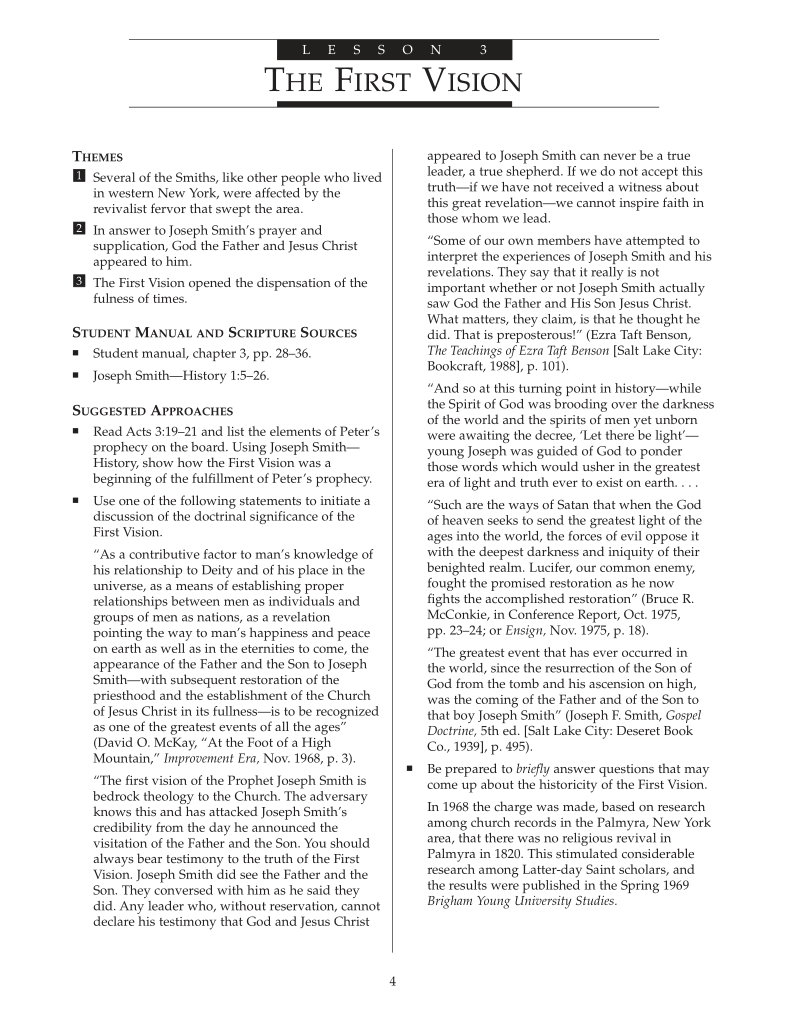CES teacher's manual that recommends scholarship on First Vision.
- Type
- Book
- Source
- The Church of Jesus Christ of Latter-day Saints LDS
- Hearsay
- DirectSecondary
- Reference
Church History in the Fulness of Times: Teacher Manual (Salt Lake City: The Church of Jesus Christ of Latter-day Saints, 2001), 5
- Scribe/Publisher
- The Church of Jesus Christ of Latter-day Saints
- People
- The Church of Jesus Christ of Latter-day Saints
- Audience
- Latter-day Saints, Reading Public
- Transcription
THEME SOURCES
- Comprehensive History of the Church, 1:49–68.
- James E. Faust, in Conference Report, Apr. 1984, pp. 91–95; or Ensign, May 1984, pp. 67–69.
Lists major teachings and historic results of the First Vision, and concludes that it was the most important event since the Resurrection.
- Milton V. Backman, Jr., “Confirming Witnesses of the First Vision,” Ensign, Jan. 1986, pp. 32–37.
Contemporaries of the Prophet, including Orson Pratt, Orson Hyde, and John Taylor, relate what Joseph told them about the First Vision. These accounts harmonize in all important details with Joseph’s own written statements.
- Milton V. Backman, Jr., “Joseph Smith’s Recitals of the First Vision,” Ensign, Jan. 1985, pp. 8–17.
An analysis of four major recitals of the First Vision by the Prophet. The author argues that whatever differences exist between the accounts are due to their being prepared at different times for different audiences. Thus they emphasize different aspects of the experience.
ADDITIONAL SOURCES
- David O. McKay, “At the Foot of a High Mountain,” Improvement Era, Nov. 1968, pp. 2–3.
Maintains that while numerous inventions have benefitted mankind through the ages, the First Vision is unique because it alone satisfied man’s innermost yearning to know the Lord.
- Dean C. Jessee, “The Early Accounts of Joseph Smith’s First Vision,” Brigham Young University Studies, Spring 1969, pp. 275–94.
This article reproduces the various accounts of the First Vision.
- Richard L. Anderson, “Joseph Smith's Testimony of the First Vision,” Ensign, April 1996, pp. 10–21.
The best summation to date of the First Vision accounts. Provides a rebuttal to some of the historical challenges to the First Vision. This article was approved by the First Presidency and the Quorum of the Twelve for publication.
- Milton V. Backman, Jr., “Awakenings in the Burned-over District: New Light on the Historical Setting of the First Vision,” Brigham Young University Studies, Spring 1969, pp. 301–20.
In responding to critics who claimed there were no revivals in Palmyra in 1820, the author demonstrates that there were several revivals or reports of “unusual religious excitement” a few miles from the Smith home.
- Richard Lloyd Anderson, “Joseph Smith’s New York Reputation Reappraised,” Brigham Young University Studies, Spring 1970, pp. 283–314.
Maintains that the affidavits compiled by antiMormons Philastus Hurlbut and A. B. Deming were not accurate representations of the opinions of many of Joseph’s neighbors regarding the character of the Smith family.
- Milton V. Backman, Jr., Joseph Smith’s First Vision: Confirming Evidences and Contemporary Accounts, 2nd ed. (Salt Lake City: Bookcraft, 1980).
The most complete text covering the historical setting and the various accounts of the First Vision.
- Larry C. Porter, “Reverend George Lane—Good ‘Gifts,’ Much ‘Grace,’ and Marked ‘Usefulness,’” Brigham Young University Studies, Spring 1969, pp. 321–40.
Contains new information regarding Reverend George Lane, who, according to William Smith and Oliver Cowdery, was instrumental in awakening Joseph Smith’s interest in seeking the Lord in prayer.
- Citations in Mormonr Qnas
The B. H. Roberts Foundation is not owned by, operated by, or affiliated with the Church of Jesus Christ of Latter-day Saints.

